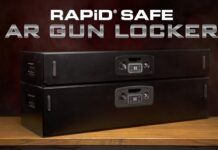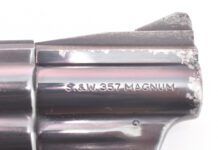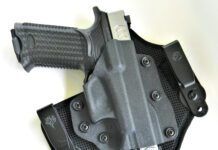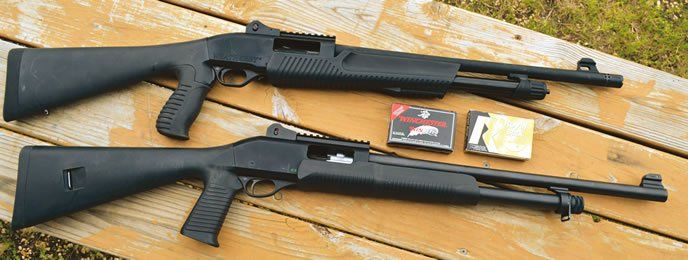
Specific-use firearms such as tactical shotguns that are designed for self-defense situations are held to a higher standard than other shooting tools. If a self-defense shotgun fails to function or inadequately performs at the wrong time, there is no such thing as a do-over. Admittedly, most of these shotguns will never be fired in a life-or-death situation and generally don’t see a lot of time on the shooting range. That does not mean the tactical shotgun owner does not demand the shooting tool, when it is necessary, handle its duties in an efficient and effective manner.
This is the first of two tactical pump-action shotgun evaluations. The next head-to-head match will feature a Tristar TEC-12 Pump/Auto 12 gauge listing for $689 against a Mossberg Model 590 Magpul Pump 12 gauge listing for $773. In that review, we will also name Our Pick of the four shotguns put through exactly the same test drills.
For this test, we selected a couple moderately priced pumps to see how they fared on the shooting range and whether they met the high standards of a firearm that might mean the difference between life and death. The two 12-gauge pump-action shotguns, both available for less than $500, that we put through their paces are the Weatherby PA-459 TR with a manufacturer’s suggested retail price of $499 and the CZ-USA Model 612 HC-P 12 gauge (last reviewed in October 2013) listing for $366.
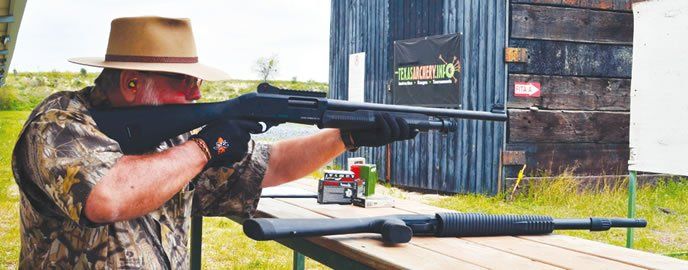
When a shooter absolutely, positively, without-a-doubt has to stop a threat, he or she can’t have doubts about whether a firearm will function in a proper and effective manner. Not only does the self-defense firearm have to perform well, a shooter must have confidence the pattern will be placed on target in an effective manner. Also, a key element in any self-defense training is that the shooter is responsible for any lead that comes down the barrel in a shooting situation. Wounding or killing an innocent bystander with an errant pellet or slug is simply unacceptable on both moral and legal levels.

Spending time on the range to know how well a shotgun performs is a necessary factor with self-defense shotguns. Understanding that a typical tactical firearm packs quite a punch on both ends, we endured quite a bit of shoulder shock in conducting evaluations on these firearms. We encourage individuals who purchase these firearms do the same so they will become familiar with their specific self-defense tool.
Our ammunition for putting the two close-quarter shotguns into play included Rio Royal Buck 2.75-inch loads moving nine pellets of No. 00 buckshot at an average muzzle velocity of 1,345 fps; and Winchester Reduced Recoil Winlite 2.75-inch loads pushing 0.9-ounce 400-grain Sabot Slugs with an average muzzle velocity of 1,450 fps. In addition, our repeated function-fire and cycling rounds as part of the testing sequence were Remington ShurShot Heavy Dove 2.75-inch loads with 11⁄8 ounces of No. 6 shot moving at an average of 1,255 fps.
Rather than the standard patterning board used for our other shotgun testing, we utilized Birchwood Casey Eze-Scorer 23-inch by 35-inch Bad Guy and the same size Targets Online paper images of potential threats for our shots in home-defense simulations; and Champion VisiColor Zombies 12-inch by 18-inch Slasher Tusks targets for slug shots at 25 yards. On the zombies, only head shots were counted as acceptable results with the slug ammo. Here are our findings:
CZ-USA Model 612 HC-P 06510 12 Gauge, $366
Billed as ideal for horde control (that is what the HC stands for in the model number), this pump-action shotgun lists for $20 more than when GT matched it against a couple other self-defense shotguns in October 2013. Because the moderately priced pump fared so well in that review (earning a B+ rating), we decided the CZ 612 would be an appropriate match against a similar Weatherby that is available for just under $500. TombstoneTactical.com sold it for $374 when we last checked, HinterlandOutfitters.com listed the Horde-Control Pump for $346; and DefenderOutdoors.com had it on for $314.
As noted in the earlier review, the handling features of the CZ 612 were considered favorable for all members of our team. The lightly grooved full-length pistol grip and larger forearm with straight-line grooves instead of standard checkering allowed us to maintain good target holds when firing this shotgun at the targets.
The heft of the CZ 612 was quite nice, tipping the scales at an even 7 pounds, and its weight probably helped tame some of the recoil from firing the heavy loads. Shoulder shock was not unpleasant, which we attribute to the large, thin-profile forearm and comfortable full-length pistol grip.
One particularly pleasing feature was the Ghost Ring sights, featuring red-fiber bars on each side of the peephole rear sight, and a chartreuse bar in the front sight protected by a set of ears that have cutouts to assist with sight visibility. We found this combination to be very clear and effective in putting patterns or slugs in the right place. Shooting at a zombie hog target set 25 yards downrange, a rapid-fire five-shot group of sabot slugs resulted in a 4-inch spread. All shots were in the head (one struck exactly in the middle of the hog’s forehead) and target acquisition was very easy between shots.
Moving on to a home-defense situation, we set up a scenario in which three potential threats were handled with five shots of No. 00 buckshot. Timed, the CZ 612 was slightly slower in the speed run than the W’by, but produced better hits. Engaging the first target with two shots; the second target with one shot, and the third with two shots while moving from one side of a barricade to the other between the third and fourth shots to handle the third target took 5.61 seconds. The breakdown of the sequence was 1.07 seconds to touch off the first shot; 1.84 seconds for the second; 2.60 seconds for the third; 4.81 seconds for the fourth; and the clock stopped at 5.61 seconds with the final shot. All of the buckshot loads were center mass on the targets, with an average pattern of about 6 inches across.
We were particularly impressed with the CZ 612’s smoothness in the way the pump action worked and in how easily the sights could be aligned on target. The Remington No. 6 shotshells used in function-fire and speed-fire testing cycled smoothly, and we did not notice excessive recoil during the rapid-fire drills.
The CZ 612’s trigger-pull broke at 6.5 pounds, a full 2 pounds lighter than the Weatherby, which we considered another mark on the plus side for the smooth-handling CZ. If a shooter is interested in upgrading the optic selection, the CZ 612 also features a Picatinny rail on top of the receiver, allowing for the easy installation of a laser or red-dot scope above the Ghost Ring sight.
Our Team Said: Very comfortable and easy to shoot, the CZ 612 produced smooth and accurate results with both slugs and No. 00 buckshot while cycling the No. 6 shotshells with authority. We liked the way the shotgun handled and believe it would be a fine shooting tool for tactical situations.
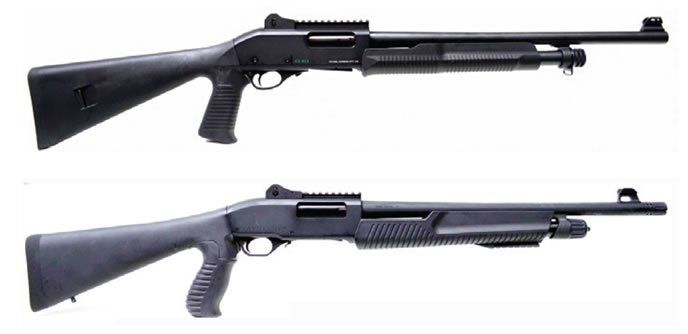
Weatherby PA-459 TR 12-Gauge Pump Shotgun, $499
Other pumpguns in the “TR” Threat Response line include the entry-level PA-08 TR, $399 list, which has an injection-molded synthetic stock without the pistol grip; the PA-459 Digital TR, $569 list, whose stock is dipped in universal digital camo; and the top of the pump line PA-459 TR 8-Shot, which features a magazine capacity of seven 2.75-inch shells (plus one in chamber) for $599 list. CheaperThanDirt.com listed this model for $415; BudsGunShop.com had a cash price for this unit of $380.
Similar in design to the CZ 612, the Weatherby is slightly shorter — an overall length of 39.5 inches compared to 40.25 for the CZ — and weighed 6.5 pounds. In the case of this tactical firearm, we found that lighter is not necessarily better. That half a pound did make a difference in our shoulder shock experience. Our shooters experienced more felt recoil when touching off shots with this shotgun, and the resulting patterning performance suffered.
Though the Weatherby also sported an adjustable Ghost Ring sight, the white bars below the peep hole did not provide the high-quality sight picture offered by the CZ 612, in our opinion. Staying on target when firing at the zombie hog 25 yards down range was more difficult, our shooters said. The five-shot pattern of 5.75 inches — two shots out of the killing zone of the head — was disappointing to us.
Perhaps more than the CZ 612, this shotgun could be improved with the installation of better optics on the Picatinny rail topping the receiver. There is also another rail on the front of the forearm that could be put into service by providing a platform for the attachment of a light or laser.
We did like the feel of the slightly larger full-length pistol grip featured on the Weatherby. Our shooters said it helped with handling and moving the shotgun onto targets, which showed at the range. In the home-defense scenario, the Weatherby was a tad bit quicker in the speed run. The first shot was fired at 1.0 seconds; the second at 1.60 seconds; the third at 2.32 seconds; the fourth at 4.41 seconds; and the final shot at 5.11 seconds. We felt this was good speed, although the patterns with the No. 00 buckshot were slightly larger than the ones with the CZ 612 — measuring about 8 inches across — and were slightly low on the center mass.
We did note that the screw-in choke that features gas release holes did not seem to have any impact on recoil. This lighter shotgun just seemed to have more recoil than the other shotgun.
Our Team Said: Overall, the Weatherby does fall into the category of being an effective, serviceable tactical tool, but it was just not up to the performance level of the CZ 612, in the opinion of our shooters. Add in its higher price tag, and the Weatherby claims second place in this head-to-head.
Written and photographed by Ralph Winingham, using evaluations from Gun Tests team testers.

























